Two years after releasing its biggest RIB model, Sealegs has given its flagship beast an overhaul. Freddy Foote gets aboard and checks out what’s new on the Interceptor 9000.
After more than 15 years of crawling my way over a wide variety of boats, I think there is probably nothing cooler than a Sealegs. I’ve said this before, but being able to drive a boat from land to water and back is not only cool but immensely practical.
Having entered the market out of nowhere 12-years ago, Sealegs have cemented themselves as an innovative Kiwi boat builder, established a healthy global distribution network and have their amphibious craft working in waters all over the world.
The Interceptor 9000 is the largest boat to come out of the Sealegs factory and two years since its launch has been given a bit of a revision by the Sealegs team to make a great boat that little bit better.
“Since we released the model two years ago, the response has been good. The first boat went to a customer in China, and since then we have sold models in Australia, the US and here in New Zealand which has proven the concept of a much larger Sealegs platform,” says Sealegs Sales & Marketing Manager Peter Small.
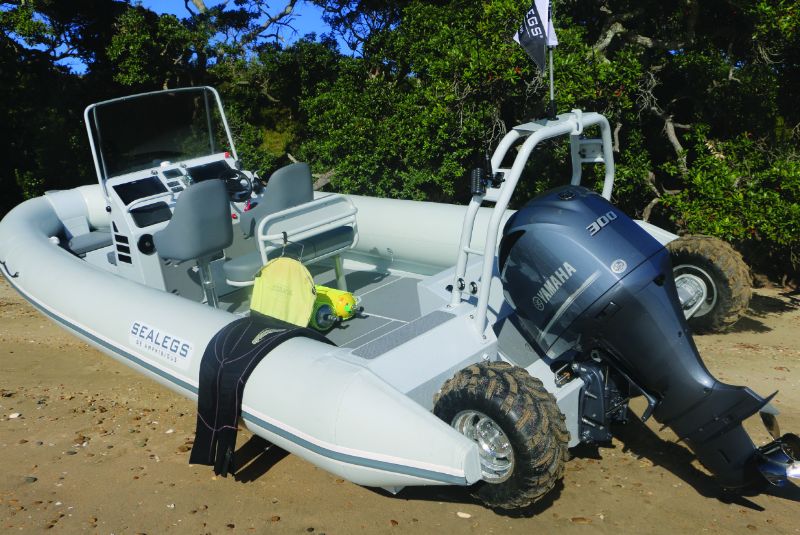
“The introduction of the model was driven by customer feedback, wanting a boat that will perform in rough water but also with a generous amount of internal space.”
This 2017 version of the Interceptor 9000 has undergone some minor changes. Gone is the onboard power pack that was located in the stern, this system, now called Hydrosol (inboard motor and hydraulic pump), is housed under the helm console to further maximise cockpit space.
The slightly larger console to house the Hydrosol allows much larger electronics packages to be fitted – as we see on our test boat with the two 16” Simrad MFDs. Also new is a more ergonomic right-hand side outboard throttle control and a larger windscreen for increased wind protection.
Those who will be more familiar with a Sealegs, will ask, with the Hydrosol now situated under the helm, how is it exhausted? Without running the exhaust down the inside of a 9m boat, Sealegs have designed a thru-hull exhaust with a baffled valve system that allows it to exhaust through the hull on land.
“We feel that with this new configuration the boat is a blank canvas for people to customise the layout and configuration how they choose.”
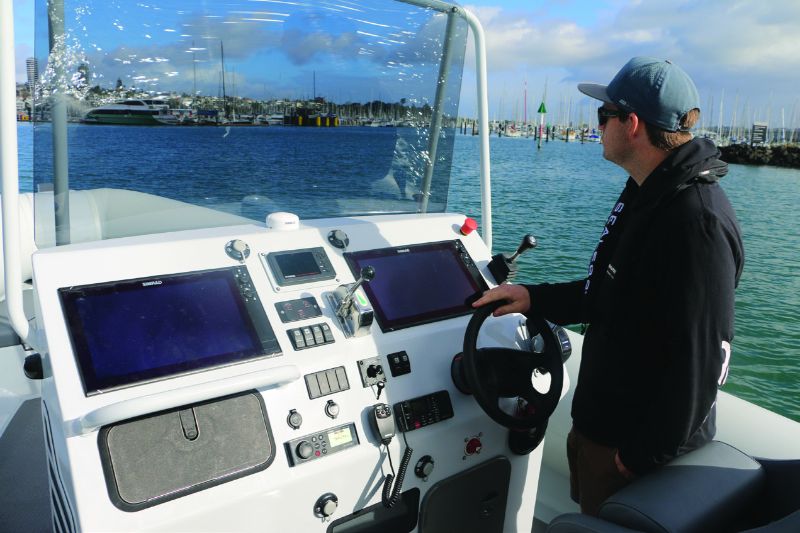
Blank Canvas
The best way to describe the Interceptor 9000 is voluminous. I can’t recall being on a RIB with so much functional space.
As Small eluded on our morning on the water, the Interceptor 9000 is essentially a very large blank canvas with a wide variety of configuration options available.
Our test boat had two pedestal seats at the helm, with a fixed passenger bench seat with backrest located immediately behind.
Other seating options include up to eight shock rider pedestal seats – the kind of configuration you’ll opt for if you are planning on invading a small island nation. Or you can specify a full-length bench seat across the transom should you have socialising and entertaining in mind rather than on water special tactics.
Forward of the helm, there is the traditional layout configuration you tend to find on a centre console RIB. In front of the helm console is a large bench seat large enough for two adults with storage underneath.
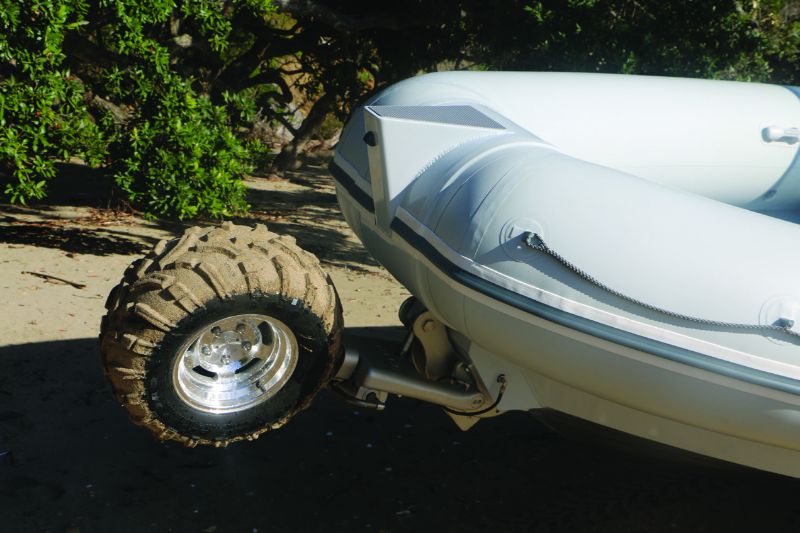
Forward of that and facing aft is sizeable bow seating area, also big enough for two adults; again there is storage space underneath for the anchor, rope & chain.
Lifting Davits are built into each corner of the 9000 fore and aft. Serving two purposes; allowing Sealegs to export the boats as easily on cradles as deck cargo, but also giving owners the option of being able to lift the boat onto a larger craft should they choose – as a super yacht tender for example.
Additional storage consisting of an underfloor locker immediately behind the helm, big enough to store dive bottles. And there are three lockers built into the transom. Across the transom is a sturdy ski arch that features navigation lighting, VHF aerial and mounts for portable rod holders.
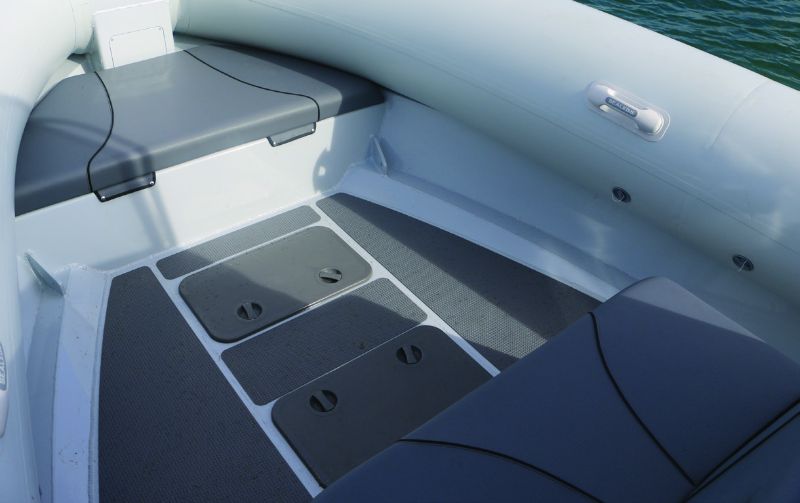
How does it work?
A Sealegs boat is a great bit of kiwi ingenuity, and having been through the company’s Albany factory, it is amazing to see how much of the mechanical parts of the system are built in house.
The Sealegs system works by having motorised wheels, two aft and one for’ard that gives the skipper the ability to drive up to 7.5km/hr on land. Such is the power, and the torque of the 35hp Honda onboard motor is that you can navigate gradients up to 25% going either up or down.
Once in the water, the skipper retracts all three wheels into the ‘Up’ position until they are completely out of the water. The skipper then engages forward gear with the outboard and drives the craft as normal.
When approaching land, the Sealegs wheels are lowered into the ‘Down’ position while still moving in the water; the skipper will engage drive to the wheels, then turn off the outboard.
Should you need to, you can lower the boat down onto its belly, allowing passengers to disembark.
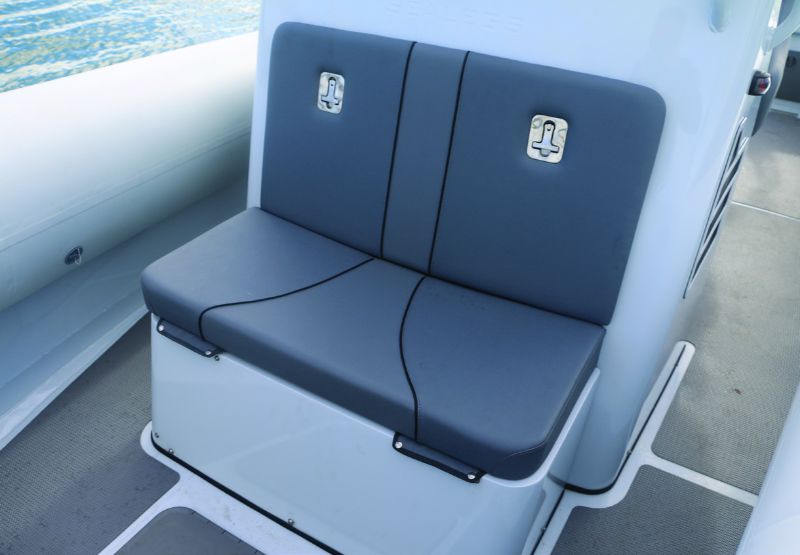
Enough Power
The Interceptor 9000 is rated for 300hp outboards. Most 9000 models leave the Sealegs factory with the 300hp four-stroke as we see here on our test boat, though you could opt for twin 150hp four-stroke outboards should you choose.
Our test boat was powered by a Yamaha 300hp four-stroke outboard, and it performed exceedingly well. It will deliver a very respectable 40 knots hitting the maximum 6100rpm and burning 103L/H.
It was a boat that I struggled to drive slowly, which isn’t a bad thing. With a very light chop on the harbour, I found that it was happiest at 32knots @ 5000rpm using 66.3L/H. Go a bit slower, down to 25 knots @ 4000rpm, and the 300hp Yamaha is using 41.1L/H.
Our test boat came with a sizeable 250L fuel tank, and we recorded our performance figures with 125L of fuel onboard, three adults, a couple of dive bottles and minimal gear.
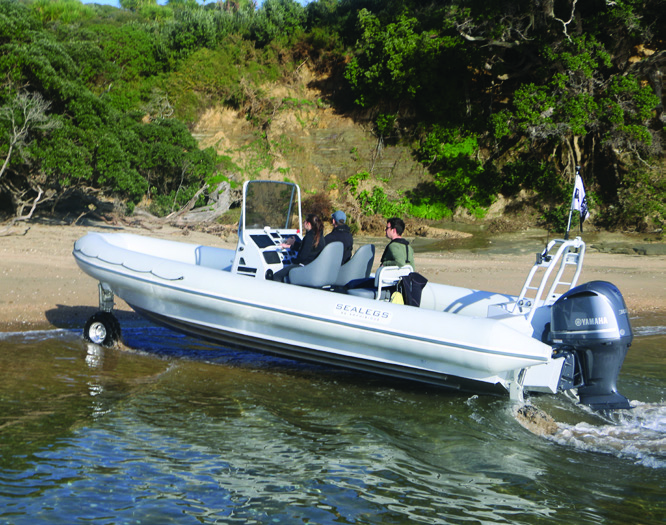
Underway the ride was exceptional. It is the kind of boat that gives you confidence in its performance and the way it will handle the chop.
The outboard was powerful enough and brought its power on gradually.
The aluminium hull was very quiet underway, and even tackling some rougher water, there was no hull noise or slapping. I’ve always thought that with a Sealegs boat; the extra weight of the wheels and hydraulics system comes into play increasing the boats performance on the water.
The ride was comfortable and dry and the pedestal seats and the helm were super comfortable to sit in though it is the kind of boat that you’ll find yourself standing to drive in.
The helm area is very well finished and has plenty of instruments to keep the skipper busy. The most notable feature in the dash are the two 16” Simrad MFD’s split by the Yamaha digital engine instrument display. Why two 16” Simrad MFD’s you ask? Well, one for the skipper and one for the navigator. You do have that island to invade remember?
For onboard entertainment, there is Fusion MS-RA70 with two speakers fitted into the helm on either side and built into the helm console is a sizeable glove box with a passenger handrail above.
Overall, a brilliant boat from a great Kiwi innovator. As tested this Interceptor 9000 is $315,000 + GST. Yes, that is a lot of money. But where else can you get a boat of this size that lets you go where this one can?
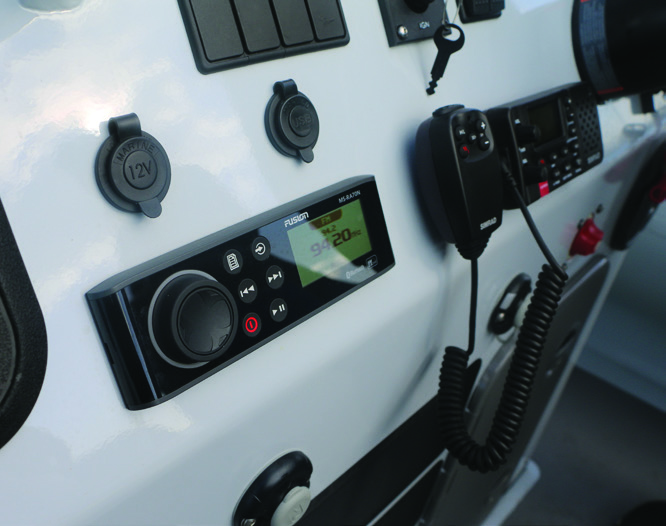
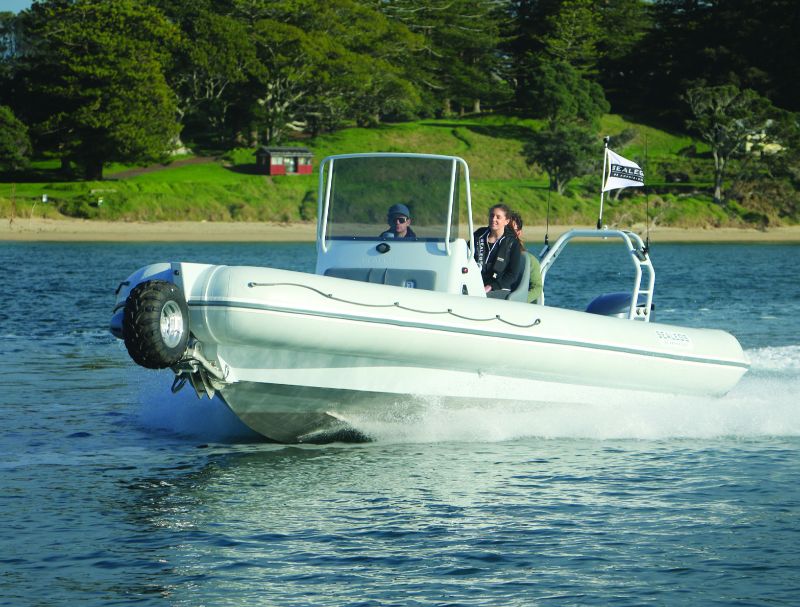
Specifications
- Model & Model: Sealegs Interceptor 9000
- Year Launched: 2017
- Priced from: $248,000 + GST
- Price as tested: $315,000 + GST
- Type: RIB Centre Console
- Construction: Aluminium
- LOA (wheels up): 9.15m
- Hull length: 7.9m
- Beam: 3.13m
- Deadrise: 23 degree
- Height Wheels Down: 2.52m
- Height Wheels Up: 2.12m
- Test Power: 300hp Yamaha Four-Stroke
- Propeller: Yamaha Saltwater Series II – I5 ¾
- Power options: Single/Twin Outboard
- HP Range: 300-400hp
- Fuel capacity: 250L
- Contact: Sealegs Ph 0800 732 5347 ,www.sealegsrecreational.com
| Performance & Fuel | ||
| RPM | Knots | L/h |
| 1000 | 5 | 5 |
| 1500 | 6 | 8 |
| 2000 | 8 | 13.2 |
| 2500 | 12 | 20 |
| 3000 | 16 | 23.8 |
| 3500 | 21 | 31 |
| 4000 | 25 | 41.1 |
| 4500 | 30 | 54.2 |
| 5000 | 32 | 66.3 |
| 5500 | 36 | 77.7 |
| 6100 | 40 | 103 |




